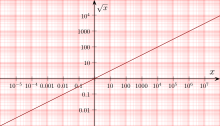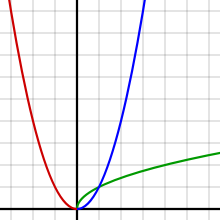Square root
The square root of a non-negative number {\displaystyle 






![{\sqrt[ {2}]{y}}.](https://www.alegsaonline.com/image/f09a5c859d31b85b7d986e72a6c54f1fa8316031.svg)





Since the equation 




In double logarithmic representation, the graph of the square root function becomes a straight line with slope 1⁄2 .
Preliminary remark on the definitions
There are two problems to be considered in the formal definition of the square root:
- If one restricts oneself to non-negative rational numbers, then the square root is not defined in many cases. Already in antiquity, it was found that the number
for example, cannot be a rational number (see Euclid's proof of the irrationality of the root of 2).
- In general, two different numbers exist whose squares agree with a given number. For example, because the number would
also be
a possible candidate for the square root of
.
The square root symbol was first used during the 16th century. It is assumed that the symbol is a modified form of the small r, which is an abbreviation for the Latin word "radix" (root). Originally, the symbol was placed in front of the radicand; the horizontal extension was missing. Carl Friedrich Gauss therefore still used brackets for more complicated root expressions and wrote, for example, instead of
In English, the square root is called "square root", which is why many programming languages use the term "sqrt" for the square root function.
Square roots of real numbers
Definition: The square root 


Equivalently, the real square root can be defined as a function like this: Let
the (bijective) restriction of the square function to the set of non-negative real numbers. The inverse function of this function 
Comments
- Note that the square function explained by
is defined for all real numbers but is not invertible. It is neither injective nor surjective.
- The constraint
of the square function is reversible and is inverted by the real root function. Since only non-negative real numbers
occur as images of , the real root function is defined only for these numbers.
- Due to the restriction of
to non-negative real numbers made before the inversion, the values of the square root function are non-negative numbers. The restriction of the square function to other subsets of
in which different real numbers always have different squares would lead to other inverse functions, but these are not called real square root functions.
Examples
| Square numbers and their square roots | ||||
| Radikand | Square root | Radikand | Square root | |
| 1 | 1 | 121 | 11 | |
| 4 | 2 | 144 | 12 | |
| 9 | 3 | 169 | 13 | |
| 16 | 4 | 196 | 14 | |
| 25 | 5 | 225 | 15 | |
| 36 | 6 | 256 | 16 | |
| 49 | 7 | 289 | 17 | |
| 64 | 8 | 324 | 18 | |
| 81 | 9 | 361 | 19 | |
| 100 | 10 | 400 | 20 | |
The square root of a natural number is either an integer or irrational. The proof is analogous to Euclid's proof of the irrationality of the square root of 2.
Properties and calculation rules
The properties of the square root function result from the properties of the square function restricted to the set of non-negative real numbers:
for
.
for
.
, i.e., the square root function is strictly monotonically increasing.
holds with the real magnitude for any real numbers
.
- On the other hand,
only valid for non-negative
.
- The square root function is differentiable on
differentiable, there
.
- At the point 0 it is not differentiable, its graph has there a perpendicular tangent with the equation
.
- It is Riemann integrable on any closed subinterval
its domain of definition, one of its primitive functions is
.

Diagram of the square function (red and blue). By mirroring only the blue half on the bisector of the 1st quadrant, the diagram of the square root function (green) is created.
Calculation of square roots from real numbers
| Rational approximate values of some |
| |
Even then, if the square root is to be taken from a natural number, the result is often an irrational number, whose decimal fraction is thus a non-periodic, non-breaking decimal fraction (namely, precisely when the result is not natural). The calculation of a square root that is not a rational number thus consists in determining an approximate value of sufficient accuracy. There are a number of ways to do this:
Written root extraction
This is an algorithm similar to the common method of written division.
Interval nesting
This procedure is quite easy to understand, although very tedious in practical implementation.
Example (approximate value for 
From 







Babylonian root extraction or Heron method
This iteration method is often used in programming the root calculation for calculators because it converges quickly. It is Newton's method for finding zeros applied to the function 
Taylor series development
The Taylor series development of the root function 



can be found, because this series for converges 



Calculation by means of CORDIC algorithm
This method is mainly used in arithmetic units, FPUs and microcontrollers.
Determining the square root graphically
One possibility is the cathetus theorem: The number 






Square roots of complex numbers
If 
exactly two solutions for 






If one writes the complex number 
where φ 



The second root value (the secondary value) is obtained by point mirroring (180° rotation) at the zero point:
Definition
The complex function "square z", 



The main branch of the complex square root function is obtained by taking as the domain of definition of
this is the right half-plane of the complex number plane, from whose edge only the numbers with non-negative imaginary part 







If 



for the main value of the square root, where the function the value -1 



The only minor branch of 
Given 

![\arg(z)\in (-\pi ,\pi ]](https://www.alegsaonline.com/image/b49f881e0c5973f5c7738a22d3b33b9a21d78558.svg)
where is 


The absolute value of the two roots is therefore the square root of the absolute value of the complex number. For the main value, the argument 
The argument of a complex number 




· Complex square root
· 
A branch of the square root
· 
Second branch
· 
The Riemann area of the square root shows how the two branches merge.
Example: Calculation of a complex square root

We are looking for the square roots of 
This gives the main value of the square root as
The other root is obtained by reversing the sign:
Power law
The power law
does not hold for 

This can already be seen from the special case resulting from the
further specification
which, because of the identity 
according to which every negative number obviously already provides a counterexample, for example 
Because 




Comments
- Since principal values of roots from positive radicands must be positive, the counterexample shows that there cannot be a square root function for which the power law
all
, cannot exist.
- For
and any one can
freely choose the "sign" of two of the three roots in
after which exactly one possibility remains for the "sign" of the last third.
Square roots modulo n
Also in the residue class ring 


However, to calculate square roots modulo must 


First determine the prime factorisation
of the modulus 

Calculation of square roots modulo a prime number p
The case 




To test whether 


because it is valid:
In the first case 


Calculation for the case p mod 4 = 3
If the Legendre symbol 
the two square roots of 

Calculation for the case p mod 4 = 1
If the Legendre symbol 
the two square roots of 


is valid. To do this, one can simply 

defined.
Calculation example for 

According to the above formula, the square roots of 
given. For 

values for 

Inserting these values gives
That is: 15 and 22 are the two square roots of 3 modulo 37.
Square roots of matrices
→ Main article: Square root of a matrix
The root of a square matrix 


As with the root of real or complex numbers, the root of matrices is not necessarily unique. However, if we consider only positive definite symmetrical matrices, the root formation is unambiguous: every positive definite symmetrical matrix 


Square root of an approximated integral operator
One can take the definite integral function 







It is vividly clear that one can repeat this operation and thus 
Thus, the matrix 
The matrix 
To draw a square root from this, one could proceed as described for the non-diagonalisable matrices. However, there is a more direct formal solution in this case as follows:
with α 


In it, the indices of α 




Thus, one can numerically approximate a "half" definite integral 


If one looks for all operators which, multiplied by themselves, give the approximated integral operator 

To derive the formula, one can first invert 

See also
- Root of 2, Euclid's proof of irrationality of root 2
- Root from 3
- Root (Mathematics)
- Modulo, residual class ring
- Penrose's square root law
Search within the encyclopedia
























![{\displaystyle {\begin{aligned}w_{1}&={\sqrt {\tfrac {2+(-1)}{2}}}+\mathrm {i} \cdot \operatorname {sgn^{+}} ({\sqrt {3}})\cdot {\sqrt {\tfrac {2-(-1)}{2}}}\\[0.3em]&={\sqrt {\tfrac {1}{2}}}+\mathrm {i} \cdot (+1)\cdot {\sqrt {\tfrac {3}{2}}}={\sqrt {2}}\cdot \left({\tfrac {1}{2}}+\mathrm {i} \cdot {\tfrac {1}{2}}{\sqrt {3}}\right)\end{aligned}}}](https://www.alegsaonline.com/image/c65fbfa85729505faa6fa18dff479108b517c08c.svg)

























